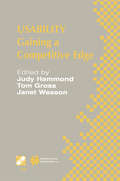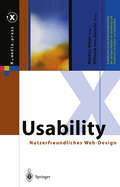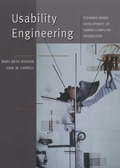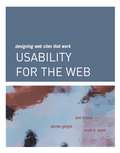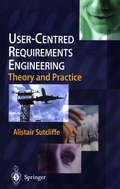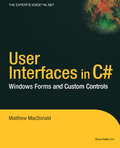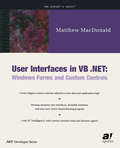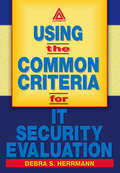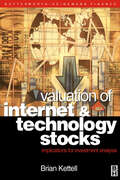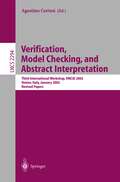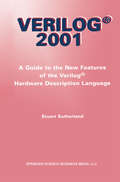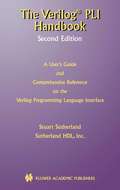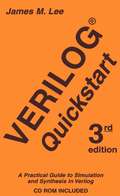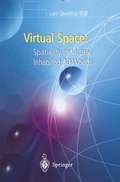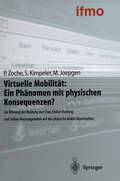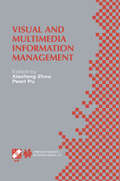- Table View
- List View
Usability: Gaining a Competitive Edge (IFIP Advances in Information and Communication Technology #99)
by JanetWesson TomGross JudyHammondUsability has become increasingly important as an essential part of the design and development of software and systems for all sectors of society, business, industry, government and education, as well as a topic of research. Today, we can safely say that, in many parts of the world, information technology and communications is or is becoming a central force in revolutionising the way that we all live and how our societies function. IFIP's mission states clearly that it "encourages and assists in the development, exploitation and application of information technology for the benefit of all people". The question that must be considered now is how much attention has been given to the usability of the IT-based systems that we use in our work and daily lives. There is much evidence to indicate that the real interests and needs of people have not yet been embraced in a substantial way by IT decision makers and when developing and implementing the IT systems that shape our lives, both as private individuals and at work. But some headway has been made. Three years ago, the IFIP Technical Committee on Human Computer Interaction (IFIP TC13) gave the subject of usability its top priority for future work in advancing HCI within the international community. This Usability Stream of the IFIP World Computer Congress is a result of this initiative. It provides a showcase on usability involving some practical business solutions and experiences, and some research findings.
Usability: Nutzerfreundliches Web-Design (X.media.press)
by Markus Beier Vittoria Von GizyckiDas Internet existiert nicht zum Selbstzweck seiner Macher. Der Nutzer steht im Mittelpunkt. Er verlangt Fakten, Unterhaltung, Ablenkung, Bestellmöglichkeit - genau das, was er will, und dies so schnell wie möglich. Kundengewinnung und Kundenbindung kann daher nur gelingen, wenn die Nutzerfreundlichkeit bei der Entwicklung einer Website im Mittelpunkt steht. Usability - das Testen der Nutzerfreundlichkeit - ist die Grundlage dafür. In diesem Buch wird das Thema Usability in seinen verschiedenen Aspekten systematisch vorgestellt, sowohl wissenschaftlich als auch praxisrelevant analysiert und durch Fallstudien veranschaulicht. Der inhaltliche Bogen reicht von der strategischen Konzeption einer Usability-orientierten Site bis zu Design, Technik und Betrieb.
Usability Engineering: Scenario-Based Development of Human-Computer Interaction (Interactive Technologies)
by John M. Carroll Mary Beth RossonYou don't need to be convinced. You know that usability is key to the success of any interactive system-from commercial software to B2B Web sites to handheld devices. But you need skills to make usability part of your product development equation. How will you assess your users' needs and preferences? How will you design effective solutions that are grounded in users' current practices? How will you evaluate and refine these designs to ensure a quality product? Usability Engineering: Scenario-Based Development of Human-Computer Interaction is a radical departure from traditional books that emphasize theory and address experts. This book focuses on the realities of product development, showing how user interaction scenarios can make usability practices an integral part of interactive system development. As you'll learn, usability engineering is not the application of inflexible rules; it's a process of analysis, prototyping, and problem solving in which you evaluate tradeoffs, make reasoned decisions, and maximize the overall value of your product.Written by prominent HCI educators who understand how to teach usability practices to students and professional developers.Interleaves HCI theory and concepts with a running case study demonstrating their application. Gradually elaborates the case study to introduce increasingly sophisticated usability engineering techniques.Analyzes usability issues in realistic scenarios that describe existing or envisioned systems from the perspective of one or more users.Emphasizes the real world of usability engineering-a world in which tradeoffs must be weighed and difficult decisions made to achieve desired results.
Usability for the Web: Designing Web Sites that Work (Interactive Technologies)
by Tom Brinck Darren Gergle Scott D. WoodEvery stage in the design of a new web site is an opportunity to meet or miss deadlines and budgetary goals. Every stage is an opportunity to boost or undercut the site's usability. Usability for the Web tells you how to design usable web sites in a systematic process applicable to almost any business need. You get practical advice on managing the project and incorporating usability principles from the project's inception. This systematic usability process for web design has been developed by the authors and proven again and again in their own successful businesses. A beacon in a sea of web design titles, this book treats web site usability as a preeminent, practical, and realizable business goal, not a buzzword or abstraction. The book is written for web designers and web project managers seeking a balance between usability goals and business concerns.Examines the entire spectrum of usability issues, including architecture, navigation, graphical presentation, and page structure.Explains clearly the steps relevant to incorporating usability into every stage of the web development process, from requirements to tasks analysis, prototyping and mockups, to user testing, revision, and even postlaunch evaluations.
User-Centred Requirements Engineering: Theory And Practice
by Alistair SutcliffeIf you have picked up this book and are browsing the Preface, you may well be asking yourself"What makes this book different from the large number I can find on amazon. com?". Well, the answer is a blend of the academic and the practical, and views of the subject you won't get from anybody else: how psychology and linguistics influence the field of requirements engineering (RE). The title might seem to be a bit of a conundrum; after all, surely requirements come from people so all requirements should be user-centred. Sadly, that is not always so; many system disasters have been caused simply because requirements engineering was not user-centred or, worse still, was not practised at all. So this book is about putting the people back into com puting, although not simply from the HCI (human-computer interaction) sense; instead, the focus is on how to understand what people want and then build appropriate computer systems.
User Interfaces in C#: Windows Forms and Custom Controls
by Matthew MacDonaldMacDonald goes beyond most other .NET books and shows how to design state-of-the-art application interfaces, concentrating on the C# language.
User Interfaces in VB .NET: Windows Forms and Custom Controls
by Matthew MacDonaldIn a new approach, this is a closely focused work that gives you the insight of experienced developers about a single aspect of .NET programming. You will find all the ingredients you can use to design state-of-the-art application interfaces. You will also delve into entirely new topics like custom control design and GDI+, the next-generation painting framework for Windows. The author goes beyond the basics and combines user interface design principles with practical guidelines for creating the next generation of software applications. The author covers three areas: 1) an overview of how to design elegant user interfaces the average user can understand; 2) a comprehensive examination of the user interface controls and classes in .NET. and 3) A tutorial with best practices and design tips for coding user interfaces and integrating help.
Using the Common Criteria for IT Security Evaluation
by Debra S. HerrmannMany organizations and government agencies require the use of Common Criteria certified products and systems and use the Common Criteria methodology in their acquisition process. In fact, in July 2002 the U.S. National Information Assurance Acquisition Policy (NSTISSP #11) mandated the use of CC evaluated IT security products in critical infrastruc
Valuation of Internet and Technology Stocks: Implications for Investment Analysis
by Brian KettellValuation of Internet and Technology Stocks offers practical information on how to value internet and high-tech companies more accurately. The book reviews previous practice, highlights the deficiencies in existing stock market techniques, and shows how to modify or replace them. It also demonstrates how the New Economics necessitates new forms of investment analysis. This book presents new ways of looking, researching and valuing internet and high-tech companies. It explains why there has been a high correlation between high loss companies and a rocketing stock price. It questions whether there is still a place for discounted cash flows when there is no cash flow to discount. It also considers what new methods are available to value super growth companies and whether these methods are any better than existing techniques. Chapters deal with a wide range of topics including: where technology/internet stocks fit in a new economy; how you value traditional common stocks; application of the Porter model to the valuation of technology/internet stocks; problems with applying traditional valuation models for technology/internet stocks; derivative markets and real options; and the lessons that can be learned by investors from the year 2000 collapse of technology/internet stocks. This text will be of interest to traders, investment managers, institutional investors, plan managers, and finance professionals.* Investigates why there has been a high correlation between high loss companies and a rocketing stock price* Questions whether there is still a place for discounted cash flows when there is no cash flow to discount* Considers what new methods are available to value super growth companies and whether these methods are any better than existing techniques
Verification, Model Checking, and Abstract Interpretation: Third International Workshop, VMCAI 2002, Venice, Italy, January 21-22, 2002, Revised Papers (Lecture Notes in Computer Science #2294)
by Agostino CortesiVerilog — 2001: A Guide to the New Features of the Verilog® Hardware Description Language (The Springer International Series in Engineering and Computer Science #652)
by Stuart Sutherlandby Phil Moorby The Verilog Hardware Description Language has had an amazing impact on the mod em electronics industry, considering that the essential composition of the language was developed in a surprisingly short period of time, early in 1984. Since its introduc tion, Verilog has changed very little. Over time, users have requested many improve ments to meet new methodology needs. But, it is a complex and time consuming process to add features to a language without ambiguity, and maintaining consistency. A group of Verilog enthusiasts, the IEEE 1364 Verilog committee, have broken the Verilog feature doldrums. These individuals should be applauded. They invested the time and energy, often their personal time, to understand and resolve an extensive wish-list of language enhancements. They took on the task of choosing a feature set that would stand up to the scrutiny of the standardization process. I would like to per sonally thank this group. They have shown that it is possible to evolve Verilog, rather than having to completely start over with some revolutionary new language. The Verilog 1364-2001 standard provides many of the advanced building blocks that users have requested. The enhancements include key components for verification, abstract design, and other new methodology capabilities. As designers tackle advanced issues such as automated verification, system partitioning, etc., the Verilog standard will rise to meet the continuing challenge of electronics design.
The Verilog® Hardware Description Language
by Donald E. Thomas Philip R. Moorbyxv From the Old to the New xvii Acknowledgments xxi 1 Verilog – A Tutorial Introduction 1 Getting Started 2 A Structural Description 2 Simulating the binaryToESeg Driver 4 Creating Ports For the Module 7 Creating a Testbench For a Module 8 11 Behavioral Modeling of Combinational Circuits Procedural Models 12 Rules for Synthesizing Combinational Circuits 13 14 Procedural Modeling of Clocked Sequential Circuits Modeling Finite State Machines 15 Rules for Synthesizing Sequential Systems 18 Non-Blocking Assignment ("
The Verilog® Hardware Description Language
by Donald Thomas Philip MoorbyXV From the Old to the New xvii Acknowledgments xx| Verilog A Tutorial Introduction Getting Started 2 A Structural Description 2 Simulating the binaryToESeg Driver 4 Creating Ports For the Module 7 Creating a Testbench For a Module 8 Behavioral Modeling of Combinational Circuits 11 Procedural Models 12 Rules for Synthesizing Combinational Circuits 13 Procedural Modeling of Clocked Sequential Circuits 14 Modeling Finite State Machines 15 Rules for Synthesizing Sequential Systems 18 Non-Blocking Assignment ("
The Verilog PLI Handbook: A User’s Guide and Comprehensive Reference on the Verilog Programming Language Interface (The Springer International Series in Engineering and Computer Science #666)
by Stuart Sutherlandby Maq Mannan President and CEO, DSM Technologies Chairman of the IEEE 1364 Verilog Standards Group Past Chairman of Open Verilog International One of the major strengths of the Verilog language is the Programming Language Interface (PLI), which allows users and Verilog application developers to infinitely extend the capabilities of the Verilog language and the Verilog simulator. In fact, the overwhelming success of the Verilog language can be partly attributed to the exi- ence of its PLI. Using the PLI, add-on products, such as graphical waveform displays or pre and post simulation analysis tools, can be easily developed. These products can then be used with any Verilog simulator that supports the Verilog PLI. This ability to create thi- party add-on products for Verilog simulators has created new markets and provided the Verilog user base with multiple sources of software tools. Hardware design engineers can, and should, use the Verilog PLI to customize their Verilog simulation environment. A Company that designs graphics chips, for ex- ple, may wish to see the simulation results of a new design in some custom graphical display. The Verilog PLI makes it possible, and even trivial, to integrate custom so- ware, such as a graphical display program, into a Verilog simulator. The simulation results can then dynamically be displayed in the custom format during simulation. And, if the company uses Verilog simulators from multiple simulator vendors, this integrated graphical display will work with all the simulators.
Verilog® Quickstart: A Practical Guide to Simulation and Synthesis in Verilog (The Springer International Series in Engineering and Computer Science #667)
by James M. LeeFrom a review of the Second Edition 'If you are new to the field and want to know what "all this Verilog stuff is about," you've found the golden goose. The text here is straight forward, complete, and example rich -mega-multi-kudos to the author James Lee. Though not as detailed as the Verilog reference guides from Cadence, it likewise doesn't suffer from the excessive abstractness those make you wade through. This is a quick and easy read, and will serve as a desktop reference for as long as Verilog lives. Best testimonial: I'm buying my fourth and fifth copies tonight (I've loaned out/lost two of my others).' Zach Coombes, AMD
Verschlüsselungsalgorithmen: Angewandte Zahlentheorie rund um Sicherheitsprotokolle
by Gilbert BrandsDer spielerische Umgang mit auch komplexeren Themen der Zahlentheorie soll dem mit Programmiertechniken vertrauten Leser zu eigenen Experimenten animieren und ein Verständnis für Sicherheitstechniken fördern, das nicht mehr von Versprechungen anderer abhängt.
Verteilte Systeme: Client-Server-Computing für Studenten und Praktiker (Viewg-Lehrbuch)
by Günther BengelAktuell, systematisch und anwendungsnah eignet sich dieses Lehrbuch gleichermaßen für Studenten und Praktiker. Das Buch behandelt die verschiedenen Interaktionsarten und -möglichkeiten zwischen Clients und Server. Das Themenspektrum geht dabei von TCP/IP-Sockets, Remote Procedure Calls, Remote Method Invocations, CORBA, Enterprise JavaBeans bis hin zu den aktuellen webbasierten Interaktionen und deren Programmierung mit HTML, Common Gateway Interface, Servlets, XML und Applets.
Video-Based Surveillance Systems: Computer Vision and Distributed Processing
by Graeme A. Jones Nikos Paragios Carlo S. RegazzoniMonitoring of public and private sites has increasingly become a very sensitive issue resulting in a patchwork of privacy laws varying from country to country -though all aimed at protecting the privacy of the citizen. It is important to remember, however, that monitoring and vi sual surveillance capabilities can also be employed to aid the citizen. The focus of current development is primarily aimed at public and cor porate safety applications including the monitoring of railway stations, airports, and inaccessible or dangerous environments. Future research effort, however, has already targeted citizen-oriented applications such as monitoring assistants for the aged and infirm, route-planning and congestion-avoidance tools, and a range of environment al monitoring applications. The latest generation of surveillance systems has eagerly adopted re cent technological developments to produce a fully digital pipeline of digital image acquisition, digital data transmission and digital record ing. The resultant surveillance products are highly-fiexihle, capahle of generating forensic-quality imagery, and ahle to exploit existing Internet and wide area network services to provide remote monitoring capability.
Video Object Extraction and Representation: Theory and Applications (The Springer International Series in Engineering and Computer Science #584)
by I-Jong Lin S.Y. Kung“If you have built castles in the air, your work need not be lost; that is where they should be. Now put the foundations under them. ” - Henry David Thoreau, Walden Although engineering is a study entrenched firmly in belief of pr- matism, I have always believed its impact need not be limited to pr- matism. Pragmatism is not the boundaries that define engineering, just the (sometimes unforgiving) rules by which we sight our goals. This book studies two major problems of content-based video proce- ing for a media-based technology: Video Object Plane (VOP) Extr- tion and Representation, in support of the MPEG-4 and MPEG-7 video standards, respectively. After reviewing relevant image and video p- cessing techniques, we introduce the concept of Voronoi Ordered Spaces for both VOP extraction and representation to integrate shape infor- tion into low-level optimization algorithms and to derive robust shape descriptors, respectively. We implement a video object segmentation system with a novel surface optimization scheme that integrates Voronoi Ordered Spaces with existing techniques to balance visual information against predictions of models of a priori information. With these VOPs, we have explicit forms of video objects that give users the ability to - dress and manipulate video content. We outline a general methodology of robust data representation and comparison through the concept of complex partitioning mapped onto Directed Acyclic Graphs (DAGs).
Virtual Space: Spatiality in Virtual Inhabited 3D Worlds
by J. F. Jensen E. Kjems N. Lehmann C. MadsenContaining the edited research papers resulting from an ambitious, cross-disciplinary research project, this volume examines the spatiality of virtual inhabited 3D worlds - virtual reality and cyberspace. (Three other volumes look at Interaction, Staging and Methodology.) It is about the communication spaces emerging at the Internet and supported by special 3D interfaces. It is also about the virtual spaces created by virtual reality hardware (CAVEs, panoramic screens, head mounted display systems etc.) and software.Virtual Space: Spatiality in Virtual Inhabited 3D Worlds is interdisciplinary. It deals with philosophical, psychological, communicational, technological and aesthetic aspects of space. While philosophy raises the question concerning the ontology of space - what is space - psychology deals with our perception of space. Communication theory looks at the way in which space supports communication (i.e. that space is a medium for communication), and finally aesthetic analyses exemplify the use of virtual space in virtual cities, in museums and in art.
Virtuelle Mobilität: Zur Wirkung der Nutzung von Chat, Online-Banking und Online-Reiseangeboten auf das physische Mobilitätsverhalten (Mobilitätsverhalten in der Freizeit)
by Peter Zoche Simone Kimpeler Markus JoepgenVisual and Multimedia Information Management: IFIP TC2/WG2.6 Sixth Working Conference on Visual Database Systems May 29–31, 2012 Brisbane, Australia (IFIP Advances in Information and Communication Technology #88)
by Xiaofang Xiaofang Zhou Pearl PuCurrent research in Visual Database Systems can be characterized by scalability, multi-modality of interaction, and higher semantic levels of data. Visual interfaces that allow users to interact with large databases must scale to web and distributed applications. Interaction with databases must employ multiple and more diversified interaction modalities, such as speech and gesture, in addition to visual exploitation. Finally, the basic elements managed in modern databases are rapidly evolving, from text, images, sound, and video, to compositions and now annotations of these media, thus incorporating ever-higher levels and different facets of semantics. In addition to visual interfaces and multimedia databases, Visual and Multimedia Information Management includes research in the following areas: Speech and aural interfaces to databases; Visualization of web applications and database structure; Annotation and retrieval of image databases; Visual querying in geographical information systems; Video databases; and Virtual environment and modeling of complex shapes. Visual and Multimedia Information Management comprises the proceedings of the sixth International Conference on Visual Database Systems, which was sponsored by the International Federation for Information Processing (IFIP), and held in Brisbane, Australia, in May 2002. This volume will be essential for researchers in the field of management of visual and multimedia information, as well as for industrial practitioners concerned with building IT products for managing visual and multimedia information.
Visual Attention Mechanisms
by Virginio Cantoni Maria Marinaro Alfredo PetrosinoProceedings of the Fifth International School on Neural Networks "E.R. Caianiello" on Visual Attention MechaProceedings of the Fifth International School on Neural Networks "E.R. Caianiello" on Visual Attention Mechanisms, held 23-28 October 2000 in Vietri sul Mare, Italy.nisms, held 23-28 October 2000 in Vietri sul Mare, Italy. The book covers a number of broad themes relevant to visual attention, ranging from computer vision to psychology and physiology of vision. The main theme of the book is the attention processes of vision systems and it aims to point out the analogies and the divergences of biological vision with the frameworks introduced by computer scientists in artificial vision.
Visual Basic and Visual Basic .NET for Scientists and Engineers
by Christopher M. FrenzHere is a concise and practical guide to help researchers and engineers who are new to Visual Basic gain a firm grasp of the topics that are most relevant to their programming needs.
Visual Basic .NET and the .NET Platform: An Advanced Guide
by Andrew TroelsenMicrosoft Visual Basic .NET provides the productivity features developers need to rapidly create enterprise-critical web applications. In Visual Basic .NET and the .NET Platform: An Advanced Guide, author Andrew Troelsen shows experienced developers how to use VB .NET for developing virtually every possible kind of .NET application. From Windows-based to web-based applications, ADO .NET, XML Web services, and object-oriented language features, it's all here. There are detailed discussions of every aspect of .NET development and useful examples with no toy code. Troelsen starts with a brief philosophy of the VB .NET language and then quickly moves to key technical and architectural issues for .NET developers. Not only is there extensive coverage of the .NET Framework, but Troelsen also describes the object-oriented features of VB .NET including inheritance and interface-based programming techniques. Youll also learn how to use VB .NET for object serialization, how to access data with ADO.NET, and how to build (and interact with) .NET Web Services, and how to access legacy COM applications. Written in the same five-star style as Troelson's previous two books, Developer's Workshop to COM and ATL 3.0 and C# and the .NET Platform, this is the comprehensive book on using VB .NET to build .NET applications that you've been waiting for! Learn from the author! Check out Andrew's workshop schedule at http://www.intertech-inc.com/courses/CourseDetails.asp?ID=99075&LOC.
